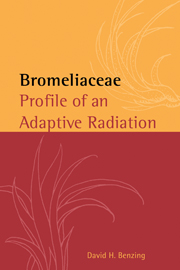Book contents
- Frontmatter
- Contents
- List of contributors
- Preface
- Acknowledgments
- Glossary
- Abbreviations
- Part one Brief overview
- Part two Basic structure, function, ecology and evolution
- Part three Special topics
- 10 Neoregelia subgenus Hylaeaicum
- 11 Cryptanthus
- 12 Tillandsioideae
- 13 Tillandsia and Racinaea
- 14 Ethnobotany of Bromeliaceae
- 15 Endangered Bromeliaceae
- Literature cited
- Name index
- Subject index
- Taxon index
13 - Tillandsia and Racinaea
from Part three - Special topics
Published online by Cambridge University Press: 19 January 2010
- Frontmatter
- Contents
- List of contributors
- Preface
- Acknowledgments
- Glossary
- Abbreviations
- Part one Brief overview
- Part two Basic structure, function, ecology and evolution
- Part three Special topics
- 10 Neoregelia subgenus Hylaeaicum
- 11 Cryptanthus
- 12 Tillandsioideae
- 13 Tillandsia and Racinaea
- 14 Ethnobotany of Bromeliaceae
- 15 Endangered Bromeliaceae
- Literature cited
- Name index
- Subject index
- Taxon index
Summary
Spencer and Smith's (1993) recognition of genus Racinaea (formerly subgenus Pseudocatopsis of Tillandsia) reflects growing appreciation that Tillandsia sensu Smith and Downs (1977), along with Vriesea, constitute a large complex of closely related species needing major taxonomic reorganization. This chapter deals with Racinaea and the remaining six subgenera of Tillandsia, many of which are likely to be redefined along with similarly paraphyletic Vriesea.
Racinaea comprises 56 mainly epiphytic species; Tillandsia includes about 550 species of terrestrial, epiphytic or lithophytic herbs of highly variable architecture ranging from phytotelm forms more than 1 m in diameter (e.g., T. grandis) to dwarf, moss-like epiphytes (e.g., T. bryoides) of c. 3 cm height (Fig. 2.1). Mesophytic taxa are usually rosulate, or possess more elongate stems if saxicoles (e.g., T. australis). Type Five species (the atmospherics) are more often leafy caulescent (e.g., T. cauligera), and lack substantial interfoliar impoundments (Fig. 2.4). Phyllotaxis is spiral or rarely distichous (e.g., T. capillaris), and the leaves are lingulate (e.g., T. fendleri) to narrowly triangular (e.g., T. fasciculata) or linear (e.g., T. setacea), green or densely cinereously lepidote with centrally symmetric scales. Blades are flat and thin (e.g., R. seemannii) or succulent (e.g., T. aizoides). Scapes tend to be distinct and equipped with foliaceous bracts that may decrease in size and shape toward the top of the scape (e.g., T. polystachia), or abruptly change to vaginiform bracts (e.g., T. fuchsii).
Inflorescences are usually compounded to form a panicle (e.g., T. marnier-lapostollei), a raceme (e.g., T. ixioides), a spike-raceme of distichous (e.g., T. clavigera) or polystichous spikes (e.g., T. spiraliflora), a digitate inflorescence (e.g., T. carlsoniae), a head (e.g., T. capitata), a simple distichous (e.g., T. xiphioides) or a simple polystichous spike (e.g., T. stricta) or rarely a single flower (e.g., T. albertiana; Fig. 3.3L).
- Type
- Chapter
- Information
- BromeliaceaeProfile of an Adaptive Radiation, pp. 573 - 586Publisher: Cambridge University PressPrint publication year: 2000



